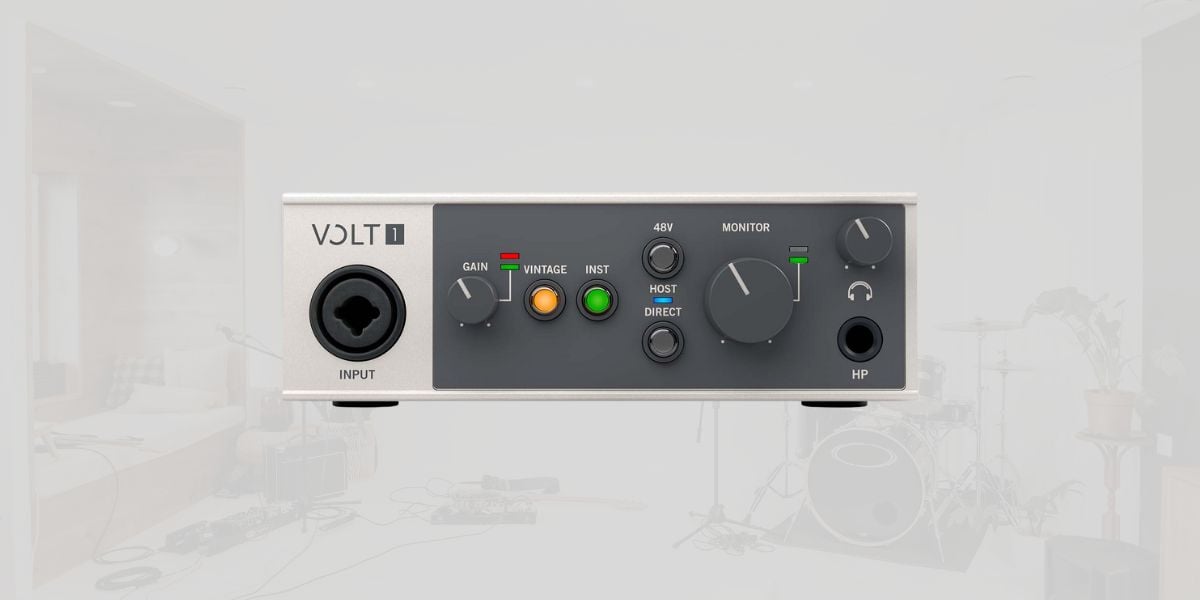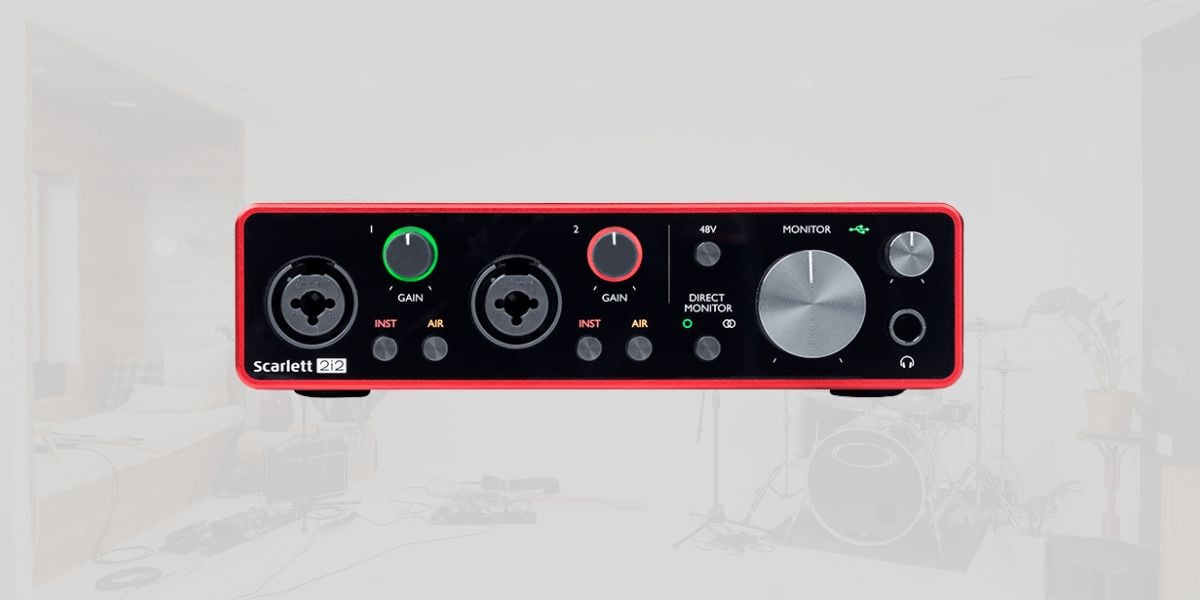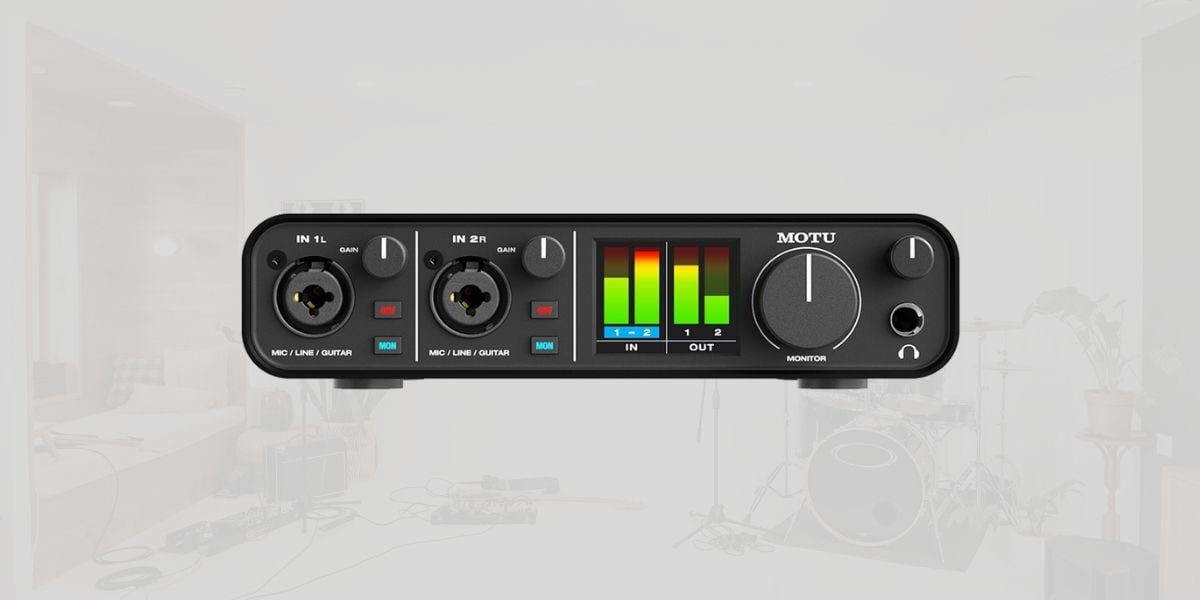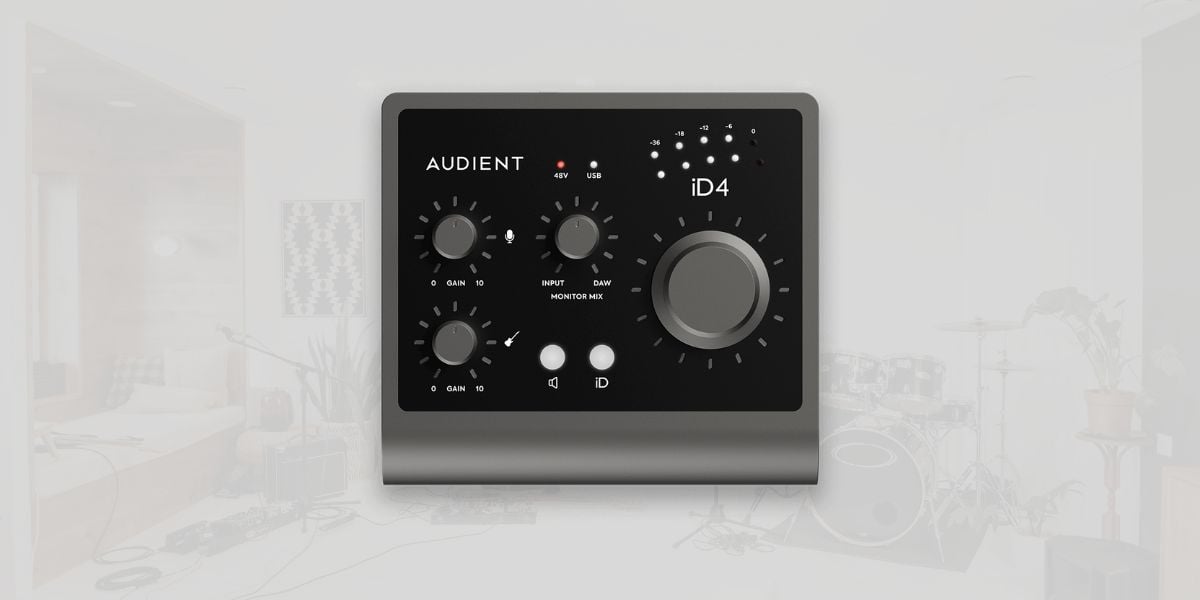Your interface is one of the most essential items in your setup (along with studio monitors), but it can also be one of the most costly. From the seemingly endless options available, we’ve picked out some of the best budget audio interfaces to save you some time researching.
We curated the list to make your decision as easy as possible. Instead of listing all budget sound cards, we included only the best affordable ones.
Each product has been selected based on different strengths that will favor a particular purpose. Meanwhile, before we get into them, let’s look at a few key aspects that might set one interface apart from another.
Selecting the best budget audio interface for your studio
Although we all have slightly different needs, a few fundamental principles benefit all audio users regardless of your discipline or the style of music you create.
1. AD/DA Conversion
The quality of your audio interface’s AD/DA converters is arguably the most crucial aspect of your home studio when it comes to recording and mixing. The AD (analog-to-digital) conversion stage happens on the way in, so this can affect the dynamics of a recorded signal.
Alternatively, DA (digital-to-analog) conversion determines the clarity and transparency of the signal sent from your DAW system to your monitors and headphones.
While both play important roles, it’s the fidelity of the DA stage we rely on during playback – so this comes into play even if you make music exclusively with samples and software instruments.
As explained in our mixing guide, the quality of your mix will largely depend on the quality of your audio recordings. By ensuring that your audio interface captures high-quality recordings, you are directly increasing the potential quality of your mix.
2. Preamps
If you plan on using vocals, guitars, synths, or other instruments in your tracks, your recording input stage is worth considering in this process.
Most audio interfaces have microphone and instrument preamps built-in with gain/trim controls and phantom power for condenser mics and DI boxes.
Be sure to check out the inputs relevant to your recording process, as they don’t all sound the same. Also, do not assume that because a certain sound card yields good results on guitars that the same will be true for vocals.
3. Features
As 2Pac once said, “How do you want it?” The form factor, layout, and specs of your audio interface will also influence your choice. The number of inputs and outputs, as well as their format (XLR, TRS, S/PDIF, MIDI, etc.), is an important factor.
In addition, you need to consider whether your PC or Mac has the right connectivity ports (USB or Thunderbolt) and if its OS version and your chosen DAW are compatible with the interface drivers.
Other features like portability or whether the device is rack-mountable can also be useful, while some interfaces ship with onboard DSP and bundled software to add to your arsenal.
What are the best budget audio interfaces in 2022?
Now that you know what to look for in an audio interface, here’s our list of the products you should consider. The listed items are suitable for audio recording, music production, podcasting, and multimedia use.
These are the best audio interfaces for home recording are:
- Universal Audio Volt 1
- PreSonus Studio 24c
- Focusrite Scarlett 2i2 3rd Gen
- MOTU M2
- Audient ID4 MKII
Let’s take a closer look at the listed interfaces.
Universal Audio Volt 1
With an outstanding reputation for analog hardware and pro audio interfaces, Universal Audio has entered the budget end of the market with the Volt series interfaces.
Universal Audio Volt 1 is a basic 1 in/2 out USB-C audio interface with a built-in microphone preamp inspired by the legendary UA 610 tube pre. It offers 24-bit/192 kHz recording, direct monitoring, MIDI I/O, and an independently controlled headphone output.
It’s bus-powered, but the 5V DC power supply can be bought separately, and the package includes a range of software from Ableton, Softube, Plugin Alliance, Relab, and Melodyne.
More info: Universal Audio Volt 1
PreSonus Studio 24c
PreSonus Studio 24c is an excellent budget audio interface for home recording and a great introduction to the Studio One Artist DAW software package, which is included.
What’s more, the XMAX preamps offer plenty of gain for dynamic mics, and the straightforward front panel layout makes operation a breeze.
It’s powered via USB-C and provides two XLR combo inputs, two TRS outputs, and MIDI I/O.
More info: PreSonus Studio 24c
Focusrite Scarlett 2i2 3rd Gen
These unmistakable little red boxes from Focusrite are the most widely used interfaces around, with a simple design philosophy and foolproof setup procedure.
Focusrite Scarlett 2i2 3rd Gen is a bus-powered USB-C 24-bit/192kHz interface with 2 ins and outs and direct monitoring, which is all the average recording musician needs.
Most devices connect via USB, so the lack of MIDI I/O shouldn’t pose a problem. Moreover, you also get a selection of software from Antares, Brainworx, Focusrite, Softube, and XLN Audio.
It’s important to mention that owning any Focusrite or Novation product (including Scarlett 2i2 3rd Gen) gives you access to the Focusrite Plug-In Collective. As a member of the Focusrite Plug-In Collective, you will receive exclusive free VST plugins and other software deals several times yearly.
Most interfaces come with a free software bundle, but Focusrite customers get access to new freebies every few months. This fact alone makes Focusrite Scarlett 2i2 3rd Gen one of the best budget audio interfaces on the market.
More info: Focusrite Scarlett 2i2 3rd Gen
MOTU M2
MOTU M2 brings the professional edge of MOTU interfaces into the budget price range. It’s a bus-powered unit with excellent ESS Sabre32 converters, 2 ins and outs, and MIDI I/O.
MOTU is known for the stability of the drivers, particularly on Mac OS, and the metering on the front panel makes it easy to optimize your gain on the way in.
Included in the bundle, you also get over 6 GB of loops and samples to get you started.
More info: MOTU M2
Audient ID4 MKII
If you prefer the desktop-style audio interface format, the Audient ID4 MKII packs everything into an elegant design that doesn’t take up much space.
The metal chassis has a simple layout, and you get separate gain controls for the XLR combo input on the rear panel and the JFET DI input on the front.
In addition, the ID4 is equipped with two headphones outs which is a great feature for an interface in this price range.
Audient ID4 MKII is an excellent budget audio interface for guitarists and singer/songwriters who need a compact solution for their home recording setup.
More info: Audient ID4 MKII
Budget audio interfaces: honorable mentions
Here are some additional budget interfaces you can try if none of the abovementioned products meet your requirements.
- Behringer U-Phoria UM2 is the cheapest audio interface you can buy. It’s a solid starting point if you’d like to spend as little money as possible on an interface.
- M-Audio M-Track Solo is another option at the very bottom of the price range.
- Arturia MiniFuse 1 is a new budget audio interface from Arturia. It looks clean and minimal, and it’s a great choice if you want to keep your home recording studio looking slick.
- SSL 2 is somewhat pricier than the other audio interfaces on the list. However, it makes up for this with its stellar recording quality and “optional sound coloration inspired by the legendary SSL 4000 series.
What audio interface are you using? Are you planning to upgrade your recording setup? Would you like to suggest an audio interface that isn’t listed above?
We’re looking forward to hearing your thoughts and suggestions in the comments section below.








24 Comments
Kevin Kitchel
onI had been using Focusrite due to lower latency over USB. Do they still have the lowest latency?
Tomislav Zlatic
onFrom my experience, there isn’t much difference between USB interfaces latency-wise nowadays. The drivers and the hardware technology improved a lot across the board. Still, it would be interesting to do a detailed comparison. Thanks for the idea!
Mafi
onMotu have the lowest latency
Alex
onNo, Motu M2 or M4 M6 has the lowest on usb and presonus quantum on thunderbolt
Pisces
onFor anyone interested in highly detailed audio card comparisons be sure to check out Julian Krause youtube channel. I learnt a whole heap from him. Peace
https://youtube.com/c/JulianKrause
Tomislav Zlatic
onGreat suggestion, thank you Pisces. Watched a few of his videos before finally purchasing my Audient ID4.
Darryl Lim
onSeconding the Julian Krause recommendation! It’s suuuper rare to find such in-depth technical reviews & explanations that nonetheless are presented in a way that is also easy to understand!
[aˈtoːm] [aːl] [ˈa(ː)tonaːl]
oni still use my yamaha ag06 and planning to switch to the new mk2 version, if necessary.
Obijon
onI swear by MOTU. 828mkII FireWire. Great preamps and 10– channel simultaneous recording in a rack mount.
Tomislav Zlatic
onAwesome, thanks for the tip!
Mafi
onI need help should I buy Motu or Audient??
Auramac
onAudient!
Darryl Lim
onMotu is better if you want among the best audio output quality, including potentially the best headphone preamps among the bunch.
Lev
onHad both of them, currently using MOTU, auident’s main “big” encoder got loose after couple of times being carried in backpack, even so if you plan to use it only inside of your studio it’s a good option. The only trouble with MOTU was-it forced me to upgrade my MacOS to Monterey one day, I was on Catalina that time and MOTU just stopped working
Mafi
onI need help should I buy Motu or Audient?
D-mac
onI’m surprised y’all didn’t include native instruments (komplete audio 1/2) which are on the same budget line as most mentioned here I personally use ka2 and it’s really fantastic haven’t had much issues and when all is good I’ll upgrade to volt or just get an actual mixer instead of a interface
Tomislav Zlatic
onGreat suggestion! We will add it to the article. It comes with a useful software bundle from NI.
Wing Yee
onI recently purchased UR22C by Steinberg for $230 Canadian.
It has all the basic audio and midi I/O.
It includes Cubase LE AI Elements 12 (DAW) & Cubasis LE (IOS), plus content softwares:
1. Groove Agent SE 5
2. HALion Sonic SE 3
3. Anima Wavetable
4. Retrologue 2
5. VST Sound Loop Set Indie Rock
6. VST Sound Loop Set Ambient Lounge
7. VST Sound Loop Set Progressive House
Yamaha Basic FX Suite V2.0.0:
– Sweet Spot Morphing Channel Strip
– REV-X
– Guitar Amp Classics
atlant
onapogee duet firewire
Delta Water Bravo
onI’ve been using the Focusrite Scarlett 2i2 for my church Livestream USB interface. However, due to setup requirements of sending that USB audio to 3 sources (Zoom Meeting, YouTube, and a hearing assist device), I felt the 2i2 was overburdened. It was doing well with what I asked, but I just felt like things could be better.
Enter Sweetwater staff. I first tried the Audient ID14 MkI demo model. It would have sounded great, but my setup requires me to use a mixer auxiliary that was too hot for the Audient. There was no way to lower that aux without upsetting the mix signal to noise. I needed a interface that kept line level activated upon restart. So I sent that back and the suggested Presonus 68c was sent out. Wow! This is a great USB interface. And I have a DAW, Studio One Artist 6, that I can use to shape my audio with plug-ins, sending the sound easily back to the 68c and on to the Livestreams on Zoom and YouTube.
Anyway, great article. The 24c is the smaller version of the 68c. It’ll sound clean and clear. And it handles mic and line level sources easily.
Nikola
onI have come to realize that no feature set is worth any money if your interface has drivers that are not regularly updated, not stable or get abandoned. After years of working with audio, that is my number one concern while choosing or suggesting audio interfaces. Availability of flexible software mixer for it, able of direct monitoring the second. I’d rather go with used, older RME over any new budget interface, and compensate for lack of easily marketable features that are often promised, but sometimes fail to deliver because of dodgy drivers. RME interfaces happily work rock solid for years, sometimes getting significant driver updates, years after. In the end, they end up well worth the extra money. I find used upper class proven gear a better deal than what you can buy new for the same price. Not very exciting, I know 😀
Henri
onGood riund up. How about the Tascam US-2x2HR ? The article could also spend a word on USB Class compliance. ;)
RA
onHi, it’s my first time here and I find everything very interesting. It’s important to know that places like this exist, where you can find a compass to orient yourself when you don’t have your own.
I would like to share my experience, albeit completely out of fashion: I still use a Terratec EWS 88-MT sound card, with midi IN/OUT, 8 IN/8 OUT mono mounted on a separate chassis which can be used both as an external and internal module at the PC. The drivers have not been updated for some time, yet I have used this card on all Windows operating systems, from XP to 10.
I also have an external M-Audio Audiophile USB which, in fact, I’ve never used because it often created problems for me and, with its price at the time, around €160.00, today I would certainly buy better products.
I paid a lot for Terratec: 22 years ago, the equivalent of around €480.00 today and I’d say it was an excellent purchase. Today you can find used ones for €60/70 and, if you consider that you can mount 4 together, you can get up to 32 analogue IN/OUTs, the equivalent of a top-level professional studio enclosed in a PC. To connect and record live a band with a synth, electronic drums (or acoustic drums with microphones connected to another mixer), guitar, bass and a microphone, you only need one!
Certainly it is better to buy newer products but, in making a choice, I think it is also important to think about the life cycle of the product.
Thanks for the space granted and good music to all.
Gail
onHow can I get my Motu M4 to more reliably stay connected to my Computer so my computer can access it? I don’t know if this is an issue of the cable, or the laptops / laptop hubs I try to use, or the Motu or its driver, or the level of power it is supplied. The Motu is definitely on, even when disconnected, so I can listen to myself using the mic.